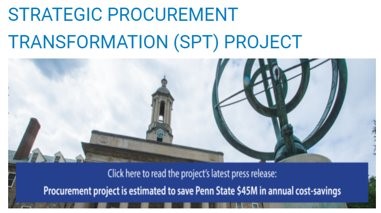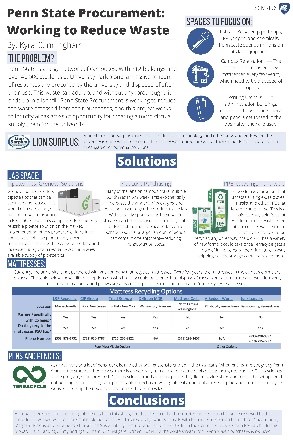Explore the wide range of successful project examples by scrolling through or select a topic of interest from the list below.
- Living Filter
- Green Infrastructure
- Sustainable Procurement
- Carbon Footprint of Campus Food
- Solar
- Bird Strikes
- Student Farm
- Green Labs
- Water Resource Engineering
- Black Walnut Provenance Study
- Student Sustainability Advisory Council
- Independent Projects & Internships
- Class Projects
Living filter
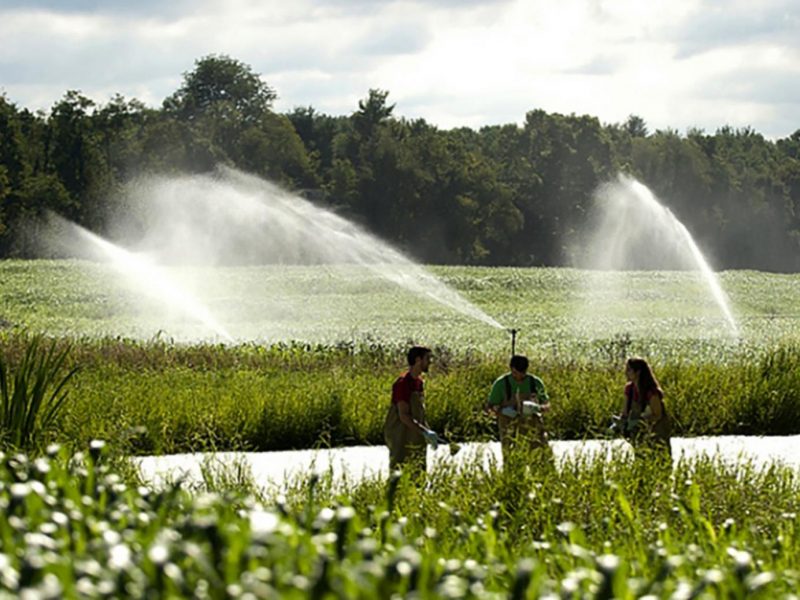
Image source
Begun as a research project in 1962, the Penn State Wastewater Renovation and Conservation project demonstrated that treated effluent could be successfully recycled back into the water supply when applied to agricultural land under the right conditions. Today, the university pumps hundreds of millions of gallons of wastewater each year to land north of the university where, instead of being discharged into streams, it is sprayed on agricultural and forest land, and eventually replenishes local groundwater supplies.
The Living Filter provides the following benefits:
— Eliminates the direct discharge of treated wastewater into streams and other water bodies.
— Enhances the treatment of the water as it slowly percolates through the soil.
— Naturally recharges the underlying aquifer.
— Helps to maintain base flows in streams such as Spring Creek without adverse thermal effects.
— Reduces the impacts of drought conditions.
— Improves the growth and yield of agricultural crops.
A range of Living Filter and wastewater related research projects are funded each year. Review the list of FY2021 funded projects HERE
Early video of the project can be viewed at https://youtu.be/g8iYdBsTst0
Green Infrastructure
A project titled “Greening our stormwater: using campuses as living labs for green stormwater infrastructure” received funding through the University’s Strategic Plan Seed Grant program in support of the strategic planning theme of Stewarding our Planet’s Resources. The project involves an interdisciplinary team of researchers, and aims to position Penn State as a national leader in green stormwater infrastructure (GSI) by building a campus community with the capacity to implement long-term cost-effective solutions to water quality and quantity. One element of the project incorporates GSI into relevant courses and gives students hands-on experience in the design, monitoring and maintenance of GSI systems on campus and in municipalities.
Sustainable Procurement
The focus of the Strategic Procurement Transformation project is to implement procurement solutions that apply proven supply chain management processes and operations across the University. Implementing these solutions will enable the University to achieve approximately $45 million in annual cost-savings
Penn State Procurement is working to reduce the waste amassed from their purchases. A student project identified areas of opportunity for creating a more circular supply chain for the university.
See the final report HERE
Carbon Footprint Analysis of Menu Items for the Penn State Dining Services
Two EME 466: Energy and Sustainability in Society students conducted an in depth analysis of menu items for their final capstone portfolio. Partnering with the Sustainability Institute at Penn State and working with the PSU Dining Services, the students provided carbon footprint information for menu items to inform purchasing decisions. Dining Services was interested in a data inventory to help support further conversation regarding climate goals with their team and to find out about ingredients that they can swap out to further reduce the carbon impact of their dishes.
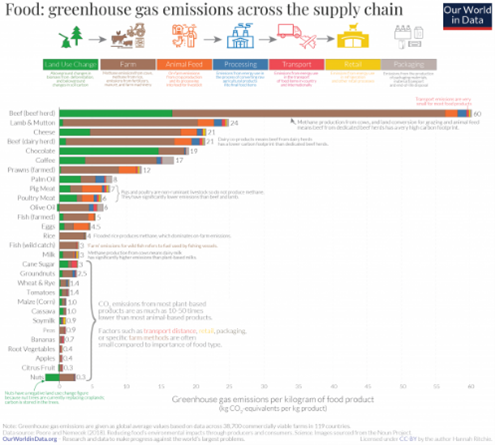
Image source
Read the report HERE
Solar
On February 5, 2019, Penn State and Lightsource bp announced the development of a large-scale, ground-mounted solar array of over 150,000 solar panels near Penn State’s Mont Alto Campus. The installation gives Penn State and the communities surrounding the installation the opportunity to learn about solar array projects and interact with them. Three Living Lab projects were proposed and are underway!
Pennsylvania’s Solar Future: Comparing Potential Between Urban and Rural Areas
Stephen Mainzer, Ph.D. & Travis Flohr, Ph.D.
Solar Array Affect on Birds
Linghao Zhong, Ph.D.
Bird Strikes
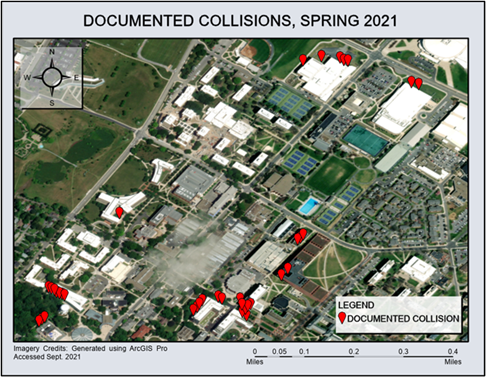
Members of the Penn State community often find dead or injured birds near windows, and local birdwatchers initiated a database in 2019 to compile that information. A collection of dozens of window-killed specimens collected by an Office of the Physical Plant staff member between 2009 and 2019 and donated to an ornithology teaching collection was added to the database. Information from undergraduate student Chyvonne Jessick’s Erickson Discovery Grant project, which systematically checked a certain set of buildings every day to compare collision rates between different facades, was also added.
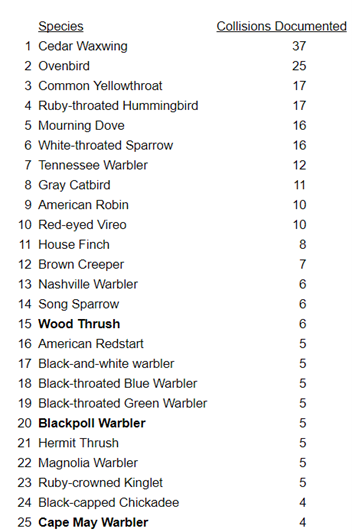
Table 1. The top 25 species with the highest documented collision frequency on Penn State University Park campus. Declining species identified as conservation priority species by Partners in Flight are marked in bold. Numbers of collisions documented are as of mid-June in 2022.
Read Chyvonne’s full report HERE.
As of June 2022, the project has identified particular buildings and windows on campus with high collision rates and catalogued over 350 individuals from 70 species of birds impacted. The project has begun to lobby the university for bird safe infrastructure improvements in a few locations where needs are greatest. The long term goal is to encourage the University infrastructure planners to adopt a bird safe glass policy for new buildings as other universities and municipalities have done.
Student Farm
The Dr. Keiko Miwa Ross Student Farm at Penn State was established to demonstrate how food is grown and to provide hands-on engagement opportunities for students and volunteers to gain skills and knowledge about sustainable food production, harvesting, and marketing. The Farm has served as a living lab for many projects. Examples include:
- Students in Biological Engineering (BE) 466 helped the Student Farm keep their harvested produce fresh by developing a cold storage solution out of a shipping container.
- Students in an English 15 class – Rhetoric and Composition – visited the Student Farm to explore how writing might bring attention to environmental concerns surrounding food waste, carbon emissions, and the personal choices we make about sustainability. The result was a series of six new tours focused on food-related topics.
- Farm intern Vancie Peacock researched potential locations for a pocket garden on campus based on slope, sunlight, access to water and other factors to learn which were most viable for growing vegetables. A proposal to the Office of Physical Plant was approved with the stipulation that all food harvested would go to the Lion’s Pantry. The Lion’s Pantry helps provide sustenance to Penn State students experiencing food insecurity.
- Students in Smeal’s Sapphire Applied Professional Experience Program (APEX) conducted a budget analysis for the on-campus Student Farm. A team of four seniors in this capstone course analyzed three years of historical financial data from the Student Farm to determine appropriate budget categories and provide a report on spending by category. From this historical data, the team developed budget projections for the Student Farm expansion. This project provided important data for ongoing farm program budgeting.
- More about Student Farm Living Lab projects is available HERE
Green Labs
In June 2021, a university-wide group of faculty, staff, and students convened to discuss this question and answered with a resounding “no.” They then asked What would a Sustainable Lab program look like at Penn State?
The result was the conceptualization of the novel Sustainable Lab Ambassador (SLA) program. The proposed SLA program utilizes the My Green Lab (MGL) professional certification process as a living lab for students to engage in evaluating, improving, and assessing the sustainability of laboratories on campus.
In the summer of 2022, the project received funding to launch the pilot SLA project in the fall of 2022 with five student ambassadors working in five different labs.
Project Goals
This project will pilot the Sustainable Lab Ambassador (SLA) program in the College of Engineering by:
- Exploring and assessing the anticipated mutually beneficial role that an individual undergraduate SLA can play during a research lab’s MGL certification effort and determining the levels to which the ambassador-lab pairing strategy benefits the student and the lab.
- Identifying the prerequisite introductory knowledge needed to implement sustainable research laboratory practices and developing this educational content into a prerequisite Introduction to Sustainability in the Research Lab microcredential badge.
- Developing a series of skill-building tasks, educational activities, and their associated learning objectives to be accomplished by SLAs to support and augment their lab’s certification effort.
- Developing a Carbon Footprint Analysis of a Research Lab microcredential badge that compares before/after energy usage data to quantify the impact of sustainability interventions in the laboratory.
- Determining the effectiveness of having SLA support for the MGL certification process by comparing metrics with labs who do not have this support.
Water Resource Engineering
A stream that runs through the Penn State Harrisburg campus stream has and continues to provide many opportunities for education of students in environmental engineering, biology, and ecology. Learn more about “The Campus Stream to Support Water-Resources Engineering and Science Teaching and Research.” These projects are led by Dr. Shirley Clark, and represent some of her Living Lab work. Learn more on her Research Projects Summary site.
Black Walnut Provenance Study
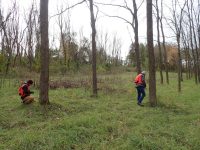
Provenance trials are designed to yield information about adaptation of tree populations to their environments that can’t be discovered through modeling simulations or DNA analyses. The seedlings of 36 tree populations were planted by faculty and students and represent the entire black walnut range. Since 1980, they have provided a place for students to be involved in research about spatial change in climate. Each row of trees comes from one location, or provenance, and the differences between them are mainly genetic. Each population is presumably adapted to the seed origin’s climate and therefore has been subjected to a varying magnitudes of climate change.
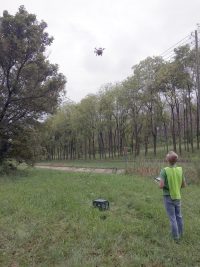 For example, a tree from Maine and a tree from Tennessee have different climate-transfer distances, enabling research about the timing of leaf emergence and leaf drop. Differences in growth among the populations and as a function of climate transfer are analyzed.
For example, a tree from Maine and a tree from Tennessee have different climate-transfer distances, enabling research about the timing of leaf emergence and leaf drop. Differences in growth among the populations and as a function of climate transfer are analyzed.
Read more about this multi-decade Living Lab project in a Penn State News article which marked the 40th anniversary of the project.
Images: Laura Leites/Penn State; Lauren Onofrio
The Student Sustainability Advisory Council
The Council consists of 25 students appointed by the President of Penn State University. Each semester the students develop ideas for improving sustainability on campus, study their feasibility, then present their recommendations to administrators at the end of the semester.
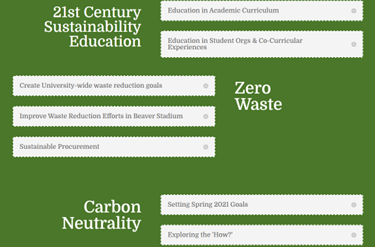
Learn more about the SSAC HERE
Independent projects & Internships
A student team in CED 475, Integrated Capstone Experience, worked with producers from Penn State’s Public Radio station to develop discussion guides for communities based on the film “Managing Risks in a Changing Climate”.
A student intern with the Sustainability Institute, whose role focused on carbon emission reduction strategies, developed a report “Feasibility Report: Implementing a Carbon Price at Penn State”. The report reviewed carbon policies around the world and in the U.S., examined carbon pricing tools and programs used by other universities, and made recommendations for Penn State.
A student intern for the Sustainability Institute, whose role focused on carbon emissions reduction strategies, worked with an interdisciplinary team of 16 faculty and staff to develop a report on a proposed “Travel Emissions Reduction Information Program” known as TRIP. The study focused on strategies to reduce Scope 3 emissions from transportation at Penn State. The student reviewed programs at other universities, examined the commuting infrastructure at Penn State, and explored the potential for engagement and education programs, offset projects, and virtual work to reduce emissions.
Class Projects
The Interdisciplinary Collaborative Studio (CoLab) in the College of Arts and Architecture is a course offered to fourth- and fifth-year undergraduate and graduate architecture, landscape architecture and architectural engineering (AE) students, in which they work on a real-world project that is either in the design or construction phase. In 2019 five interdisciplinary teams undertook a semester-long project to develop re-designs of Penn State’s Sustainability Experience Center (SEC)—a 9-acre site on the edge of the University Park campus. Their resulting visions were presented to a group of faculty, staff, and peers.
The “Oak Road Meadow Project” – a proposed planted meadow ecosystem located along Oak Road – served as a course assignment for both undergraduate and graduate landscape architecture students. Students were tasked with designing the general layout of the project and planning some of the potential features of the meadow, such as seating along the walkway through the meadow, an entry sign, a pollinator garden and locations for foliage. Sustainability was an important factor in many of the designs. In particular, the lighting throughout the meadow was often designed to use sustainable energy, like solar-cells, as a means of powering the lights. Students gave end-of-project poster presentations on their designs.
Students enrolled in the APEX (Applied Professional Experience Program) in the Smeal College of Business conducted an Opportunity Analysis for Lion Surplus, the University’s on-campus store that handles the removal and re-sale of University-owned equipment in environmentally responsible ways. The study looked at current processes used to track items sold and recommended ways that the program can more accurately report its sales data and, in turn, its waste diversion metrics.
A student class in Supply Chain Management developed a template for a sustainability review of suppliers, or Sustainability Score Card. They then applied this scorecard to the University’s top 40 suppliers.
Students in a Communications class (COMM 473) studied the Green2Go reusable take out container program (now known as PSreUse) to determine barriers to its adoption by students and develop a communications strategy to overcome them. The recommendations have contributed to a redesigned program.
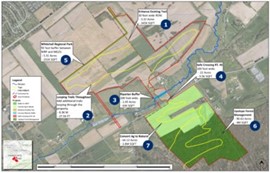
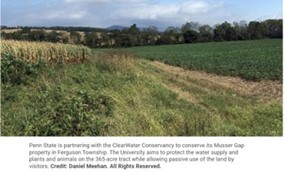
Students and faculty in the Landscape Architecture Department’s Ecology + Design research initiative played a central role in the Musser Gap to Valleylands (MG2V) project. This project, which was initiated by Penn State President Eric Barron, partnered with ClearWater Conservancy to explore environmentally responsible land use options for the roughly 355 acres the University owns between Whitehall Road and Rothrock State Forest at Musser Gap. See Penn State News stories about the Musser Gap project:
- 15 Feb 19 Landscape architecture plays central role in University’s latest conservation project
- 25 April 22: Musser Gap to Valleylands conservation plan moving forward with community input
A student project in a Labor and Employment Relations class (LER 460) helped the University’s public radio station, WPSU, to examine whether their radio broadcast coverage was well-balanced – both geographically (covering not just the immediate University Park region), and including a diversity of topics, such as race, gender and urban issues.
Another student project in LER 460 addressed diversity in hiring practices and identified local resources that may support PSU employees from culturally diverse backgrounds.
Students in a Labor and Employee Relations course (LER 460) developed a Sustainability in Recruitment Guide for integrating sustainability into the hiring process. During another semester, students in LER 460 addressed diversity hiring practices and identified local resources that may support Penn State employees from culturally diverse backgrounds.

